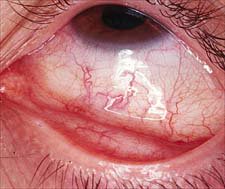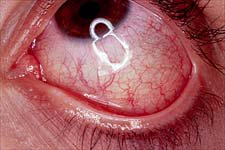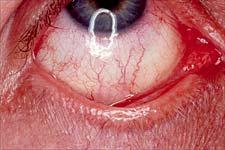New treatments play a role in complete allergy management
Recognizing and treating allergy can positively influence your practice and make a great improvement in patient quality of life and satisfaction. We have gained much ground in our understanding of the mechanisms underlying ocular allergic disease, which has enhanced our diagnostic capability and provided more treatment options.
For example, a more comprehensive understanding of the significant role that the mast cell plays in many ocular surface processes, including homeostasis, wound healing, inflammation and allergy, allows us to identify novel uses for new, more potent mast cell-stabilizing medications as they become available. In this article, we will discuss what’s new in the realm of ocular allergy, focusing on the importance of recognizing ocular allergy in the office, the role of the mast cell in multiple processes and new treatments that can play a role in complete allergy management.
New treatments
|
|
Several new concepts in allergy management are on the horizon, including immunomodulators, histamine-binding proteins and more potent mast-cell stabilizers. Specifically, some drugs we will see introduced shortly include epinastine (Allergan); a new H1-antihistamine/mast-cell stabilizer that reduces both the signs and symptoms of allergic conjunctivitis for up to 8 hours; and a new, once-daily formulation of Patanol (Alcon). This formulation contains a higher concentration (0.2%) of the active ingredient olopatadine than the currently available Patanol.
A higher concentration of a drug can translate into stronger relief as well as longer duration of action. In fact, as the mast cell-stabilizing effects are increased, the potential for additional therapeutic implications is possible.
For example, preventing the release of mastcell-derived mediators may potentially aid in regulating mast cell-mediated processes in the eye other than allergy, such as wound healing or inflammation. Often, the ocular pharmaceutical industry looks to information on drugs in other areas, such as the nose for allergy, to lead the way toward new drugs with potential applications in the eye. Although some drugs have similar benefits, there are differences between tissues and cell types in various locations of the body, particularly with regard to mast cells.
Two types of mast cells
Two primary types of mast cells are classified by their neutral protease content: those containing tryptase (MCT) and those containing both tryptase and chymase (MCTC). The ratio of these types varies depending on the tissue type and species. Accordingly, the mast cell response to drugs also differs among tissue types and species. Preclinical drug studies performed using mast cells from tissues or species other than human conjunctival mast cells have limited clinical relevance to ocular allergy. This is important to note as studies in the literature are reviewed. When assessing mast cell-stabilizing activity, it is important for the study to be performed with human conjunctival mast cells.
Role of the mast cell
The mast cell plays the central role in releasing pro-allergy and pro-inflammatory mediators, leading to the clinical presentation of allergic conjunctivitis. A sensitized individual has an allergic response to environmental allergens (pollens, dust, dander) because the exterior surface of mast cells carries IgE antibodies that recognize specific allergens. Allergens bind to IgE, signaling mast cell degranulation and the subsequent release of inflammatory mediators.
Among the released mediators are pre-formed molecules (histamine, tryptase and heparin) as well as newly formed mediators (prostaglandins, leukotrienes, platelet-activating factor, cytokines, chemokines and growth factors). In an allergic reaction, however, histamine is the single most important mediator released; it is the causative agent of allergic signs and symptoms.
Histamine binding at H1 receptors on blood vessels and nerve cells induces the vasodilatation and itching of allergy, respectively, while the stimulation of H2 receptors also contributes to the redness-causing vasodilation. If histamine itself is instilled into the eye, an exact replication of the clinical presentation of acute allergic conjunctivitis occurs. Also, if histamine levels are chronically elevated, a sustained allergic reaction is seen; one example of this is vernal keratoconjunctivitis.
Further, in patients challenged with allergen after pretreatment with the antiallergic olopatadine, tear histamine levels were reduced when compared with challenged patients receiving placebo. This reduction in histamine levels in pretreated individuals was correlated with comparatively fewer allergic signs and symptoms. Collectively, these observations demonstrate that mast cell stabilization is a key to allergy treatment by decreasing the amount of histamine released (Abelson, M.B., Leonardi, A., manuscript in progress.)
The mast cell and wound healing
Beyond its role in the allergic response, the mast cell also orchestrates wound healing by releasing mediators that participate in each stage of the healing process. Mast cell degranulation is necessary to allow wound repair to occur. Histamine, cytokines, chemokines and TNF-alpha contribute to the inflammatory process that is associated with tissue wounds. Proteases, heparin, growth factors and mast cell-driven activation of fibroblasts all contribute to the regeneration of healthy tissue and the removal of damaged tissue.
This mast cell-mediated wound healing process is triggered by ocular trauma or injury such as the incision made in LASIK surgery. While mast cell degranulation is a crucial component of wound healing, its over-stimulation may lead to complications due to chronic inflammation or altered amounts of cell proliferation. Among the side effects of LASIK are epithelial ingrowth, flap dislocation, diffuse intralamellar keratitis (non-infectious or Ralstonia pickettii associated), corneal melt and corneal haze, many of which may be directly related to the wound healing response. Potent mast cell-stabilizing agents may help prevent such situations.
While a mast-cell stabilizer will not eliminate effects of the inflammatory component of wound healing to the degree that a corticosteroid will, neither will it delay the reparative process, a common side effect of steroids. The decrease in ocular itching proffered by a mast-cell stabilizer-containing eye drop may also help the healing process by reducing the need to manually rub the eyes in post-LASIK patients. This may lower the risk for flap dislocation, particularly in those patients who suffer from ocular allergy.
Thus there may be a role for drugs with mast cell stabilizing activity as part of post-LASIK management.
Addressing all symptoms
A highly potent drug with mast cell stabilizing activity that effectively suppresses conjunctival mast cell degranulation creates the potential for more effective management of all allergy symptoms. For example, lid swelling, while it can be a major concern to patients, is rarely considered for evaluation in clinical trials or as a primary target of a pharmaceutical agent.
Quality of life can be significantly affected by the negative social connotations of eyelid swelling, particularly if occurring in combination with the redness associated with ocular allergy. These allergy symptoms could be misinterpreted as fatigue, substance abuse or illness. While this may seem a small detail to some, it can be of serious concern to those whose work, social interactions and public perceptions depend on their appearance. Lid swelling is induced by the release of the vasoactive histamine and other proinflammatory mediators from the mast cell. The effects of more potent and selective agents with mast cell-stabilizing activity may be the best chance to help reduce lid swelling, and then can not only block effects of histamine but also block release of other mediators from mast cells.
Oral vs. topical agents
While mast-cell stabilizers and antihistamines taken orally may provide some relief for ocular allergy, the opportunity for local administration via a topical eye drop provides the obvious advantage of limiting potential systemic side effects while maximizing the therapeutic effect. Systemic anti-allergic medication used for ocular allergy may cause sedation, dizziness, tinnitus or insomnia. Ironically, it may worsen the ocular signs and symptoms of allergy because another problem remains: research conducted at Ophthalmic Research Associates and presented at ARVO has shown decreases in tear film and tear flow of more than 50% with the use of systemic antihistamines in normal (non-dry eye) patients.
This is a concern when treating allergy because a compromised tear film increases the ability of the allergens to penetrate the conjunctiva and collect there. Topical medications, on the other hand, are delivered directly to the desired site, provide a higher concentration of active drug to this local area and are not prone to interact with alcohol, central nervous system depressants or other medication. For conditions such as allergic rhinoconjunctivitis, a nasal spray can be used for the rhinitis component, while an eye drop can be concomitantly used to treat the conjunctivitis component. If it is a potent agent, it may also be able to help alleviate nasal symptoms, because eye drops drain out through the naso-lacrimal duct and into the nose, where the nasal reaction occurs.
Self medicating
Many patients suffering from allergic conjunctivitis self medicate with over-the-counter therapy simply because they are unaware that superior, stronger drugs exist. The OTC medications can be irritating, causing burning or stinging. The duration of these agents is approximately 2 hours, and the recommended dosage is typically four times per day. If a patient needs all-day relief, an OTC agent is not sufficient due to the short duration and indicated limits on dosing frequency.
Recognition of allergy
The ocular component of allergy can be especially disturbing to patients. The first step in implementing proper treatment is recognizing the condition. How allergy is recognized may differ from patient to patient, but there are several keys to diagnosis.
Be proactive and ask about possible allergy symptoms. Remember that a good deal of allergy occurs year round, and that perennial allergy usually has its genesis in the home or office. Many people with seasonal allergy may not present with signs or symptoms if visiting the office during the allergy off-season or even if the environment in your office filters out allergens during sensitive times. While a patient may not be experiencing allergy symptoms at that time, you can certainly arm them now so they are ready for it when needed. Consider that itching is the most characteristic symptom of allergy. If the patient’s eye itches, it is allergy; however, if it burns, a dry eye is the more likely cause.
In addition to this rule, we need only have a small arsenal of diagnostic questions, allowing for determination of the patient’s assessment of his or her ocular symptoms (nasal and systemic may also be of diagnostic aid) and whether these symptoms are correlated to possible allergen sources. These quick questions are easily integrated into a patient medical history, and the few minutes it takes to answer them could significantly augment the care and satisfaction these allergy patients feel they are receiving.
Currently, we have the means to address allergic conjunctivitis with safe, all-day relief. In the future, as we see more potent drugs becoming available, this will have implications not only in successful treatment of allergic conjunctivitis, but also for the post-refractive surgery patient and the regulation of ocular wound healing and attenuation of eye-lid swelling.
Our abilities to recognize, understand and properly treat ocular allergy and other mast cell-mediated disorders are rapidly increasing. We are at the threshold of uncovering exciting, new, broader applications for topical ocular drugs, which can contribute to improving our level of patient care and satisfaction, giving more patients a level of freedom from worry about their ocular surface conditions they did not realize they could achieve.
For Your Information:
- Terry Chin, OD, practices at Andover Eye Associates and is an associate professor at the New England College of Optometry. Dr. Chin can be reached at 138 Haverhill St., Andover, MA 01810; (978) 475-0705; fax: (978) 475-0008.
- Kristine Erickson, OD, PhD, is an associate professor at New England College of Optometry and an associate professor of ophthalmology and pharmacology at Boston University School of Medicine. She can be reached at 863 Turnpike St., N. Andover, MA 01845; (978) 685-8900; fax: (978) 689-0020. Neither Dr. Chin nor Dr. Erickson has a direct financial interest in the products mentioned, nor is either a paid consultant for any companies mentioned.



